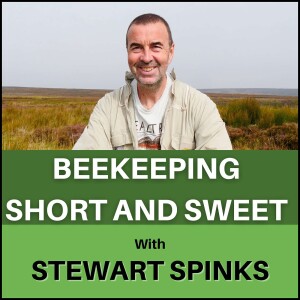
Hi, I’m Stewart Spinks and welcome to Episode 66 of my podcast, Beekeeping Short and Sweet. It’s been a busy week as we clear some of the supers ready for extraction and begin the process of moving hives to field beans.
Join me each week for my latest podcast www.patreon.com/norfolkhoney
This has to be one of the more exciting weeks of the year, as if beekeeping isn’t exciting enough, of course. We’ve been through the long, cold Winter……. well, it wasn’t that long or cold really and that seems a distant memory now. And I always get excited about the start of the new season, but then we get really busy and this year seems to have been quite swarmy, to say the least. I’ve managed to use that to my advantage and have seen a significant increase in colony numbers by making quite a number of splits and collecting several swarms that I missed from my own colonies.
I’ve had an above average number of phone calls relating to collecting swarms, the majority of them being bumblebee nests. It always surprises me that more people struggle with the simple identification of our bumblebees. That said I guess people aren’t quite so connected with the natural world perhaps as they once were, I was very lucky growing up as my grandparents lived in the countryside, we visited regularly and I didn’t have the distraction of technology in quite the way that young people have these days.
Anyway, back to the excitement of this week. Firstly, my thanks to Steph and Pete, without whose help I’d really struggle. It’s always nice to have someone to lend a hand but also someone to chat to about beekeeping, it can get quite isolating if you are on your own beekeeping. I think it’s just that we get so busy we don’t normally have much time to stop and strike up conversations. I have to acknowledge here that technology really helps bridge that void sometimes, so I’m not averse to using the mobile phone when I’m out in the apiaries, as long as I can get a signal that is.
So, I have my willing helpers on hand to assist with the lifting and being on Oilseed Rape we certainly need a helping hand. Some of the boxes were very heavy indeed.
What I thought I would do today is explain the process that I use to go from a hive full of bees to honey in buckets. I think my methods for handling the various parts of the job can be adopted and adapted by most new or growing beekeepers, and I’m changing and adapting my various methods myself as our business grows and develops.
I was chatting to Pete yesterday and describing one of my funniest extraction day memories that I had when my brother came over to help me. This was many, many years ago now and shows how we have taken some fairly large steps to get where we are now. We had removed the supers from the few hives we had, I think there must have been maybe 10 supers of honey to extract so you can see we were a very small enterprise back then. I had an old, galvanised extractor and settling tank, not something you could use these days, everything has to be stainless steel or food-grade plastic but back then we were both a lot poorer and a lot more naive about the ways of extracting honey.
Anyway, I was living in a semi-detached house with a very nice but small sun lounge on the back of the property, south facing and lovely to sit in and have a glass of beer in the late evenings. This, however, was turned into our honey room and piled high with equipment and honey boxes. We had picked a lovely day for extracting but of course, we had to keep the doors and windows shut to prevent any bees from sniffing out the honey and invading our workspace. Well, by the time we had really got started the sun was up, the room was hot and getting hotter by the minute and we were stripped to shorts and t-shirts. I think that’s probably as much detail as I should go into regarding personal items of clothing but being keen to maintain a good
More Episodes
 2024-11-03
2024-11-03
 2024-10-27
2024-10-27
 2024-10-20
2024-10-20
 2024-10-13
2024-10-13
 2024-10-06
2024-10-06
 2024-09-29
2024-09-29
 2024-09-22
2024-09-22
 2024-09-15
2024-09-15
 2024-09-08
2024-09-08
 2024-09-01
2024-09-01
 2024-08-25
2024-08-25
 2024-08-18
2024-08-18
 2024-08-11
2024-08-11
 2024-08-04
2024-08-04
 2024-07-28
2024-07-28
 2024-07-21
2024-07-21
 2024-07-14
2024-07-14
 2024-07-07
2024-07-07
 2024-06-30
2024-06-30
Create your
podcast in
minutes
- Full-featured podcast site
- Unlimited storage and bandwidth
- Comprehensive podcast stats
- Distribute to Apple Podcasts, Spotify, and more
- Make money with your podcast
It is Free
- Privacy Policy
- Cookie Policy
- Terms of Use
- Consent Preferences
- Copyright © 2015-2024 Podbean.com





